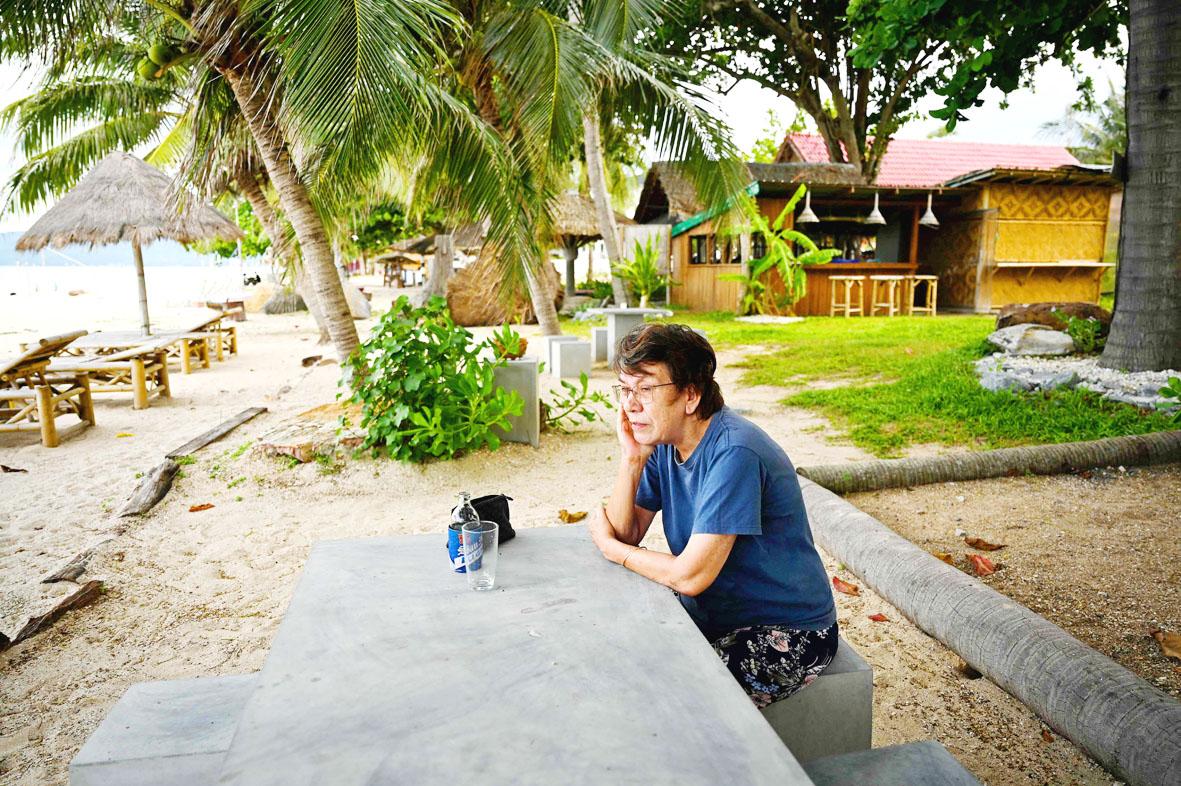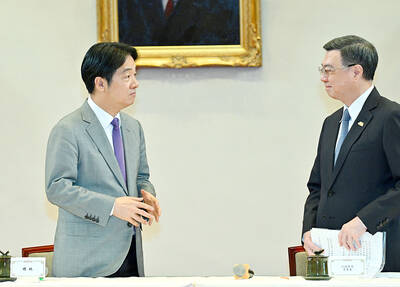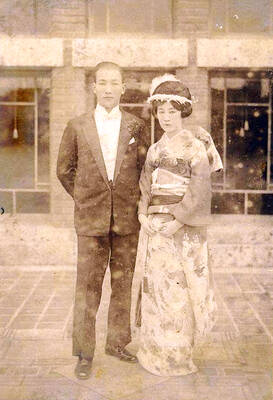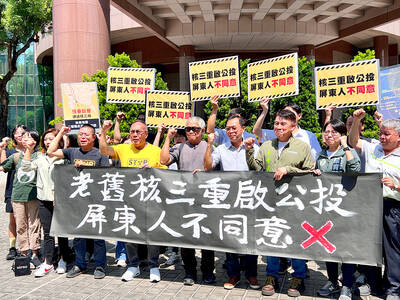Nearly half a century after he sowed fear along the 1970s “hippie trail” French serial killer Charles Sobhraj, the “Serpent” of the hit TV drama series, still haunts the lives of those who crossed his path.
Now 77 and jailed in solitary confinement in Nepal since 2003, Sobhraj is suspected of involvement in at least a dozen murders around Asia in the 1970s.
His modus operandi was to charm and befriend his victims — many of them starry-eyed Western backpackers on a quest for spirituality — before drugging, robbing and murdering them. The TV series, made jointly by the BBC and Netflix, conjures the seedy, steamy Bangkok of the 1970s with sepia tones, flared trousers and traffic-clogged streets.

Photo: AFP
French star Tahar Rahim plays Sobhraj, oozing mesmerizing, manipulative menace — in a frighteningly familiar way for one of those who knew him.
THE NEIGHBOR
When Nadine Gires visited the set of the series in 2019, seeing Rahim in character as Sobhraj brought the past flooding back.
“I was terrified. I thought he had escaped from prison, that he was coming back to do evil,” she said.
“Everything came back: anger, fear.”
Sobhraj — a Frenchman of Vietnamese and Indian parentage — arrived in Bangkok in October 1975 with his Canadian girlfriend and an Indian associate.
They moved into a flat in the same building as Gires, near Bangkok’s notorious Patpong red light district.
What became the Serpent’s lair was demolished years ago, but the disused apartment block that stood in for it in the TV series has become a minor tourist attraction.
Gires, aged 22 at the time, was impressed by Sobhraj — not least when he told her he was a gemstone trader, a tactic he used to lure cash-strapped backpackers.
“He was cultured, courteous. As neighbors, it didn’t take long for us to get to know each other,” she said.
But doubts soon arose.
“Many people were getting sick in his home. I jokingly said to Charles: ‘You’re putting a curse on them.’”
But Gires, now aged 67 and running a hotel by the beach in southern Thailand, says she had no idea what Sobhraj was really up to.
“We thought it was weird, but how could we imagine such a scheme?” she says.
But everything changed at Christmas 1975, when a young Frenchman staying with Sobhraj showed them a safe full of forged passports.
“He told us: ‘He poisons people’. He was terrified,” she explains.
“He was not only a swindler, a seducer, a robber of tourists, but an evil murderer. It had to stop.”
Together with Dutch diplomat Herman Knippenberg, she set about gathering evidence on the slippery Sobhraj, a conman with a hatful of different identities and adept at covering his tracks.
Gires searched Sobhraj’s apartment and went around backpacker haunts looking for clues about missing persons.
In one of the most dramatic, high-tension scenes of the TV show, Sobhraj bumps into her unexpectedly. The moment in March 1976 that formed the basis for the scene is still seared into Gires’s memory.
“In a hotel lobby, someone tapped me on the shoulder,” says Gires, who travelled to London to help the show’s scriptwriters.
“It was him. It was the most terrifying moment of my life.”
Fearing for her life, she agreed to let him take her home, hoping to avoid arousing his suspicions.
“My heart was beating 100,000 times a minute but he didn’t notice anything,” she says.
Even now, barely a day goes by without Gires thinking about Sobhraj, and the fear lingers.
“I need to know he is held within four walls. The thought of him being free terrifies me. What could he do now that he knows I knew?” she says.
THE POLICEMAN
Sompol Suthimai is 90 now, but the memories of his “most interesting” case still burn bright.
As a Thai police officer working with Interpol, he was on holiday in early 1976 when — under pressure from Knippenberg — the Bangkok Post published photos of murdered tourists.
“I said to myself: this is a joke — how is it possible that so many people have been killed without it being known by the police?” Sompol says.
He rushed back to Bangkok and met Knippenberg, who was initially suspicious, having tried and failed to get the Thai police to take an interest in the case.
Eventually the diplomat passed Sompol the dossier of evidence he had amassed with Gires — diaries and plane tickets belonging to the victims found at Sobhraj’s flat.
But Sobhraj had managed to flee the kingdom a few days earlier. Sompol issued an international arrest warrant. Sobhraj was arrested in New Delhi in July 1976 and spent two decades in an Indian jail for manslaughter and drugging and robbing tourists.
He went to France after his released and lived there quietly until 2003 before returning to Nepal, where he was jailed for two murders, and has been behind bars ever since.
Sobhraj’s alleged crimes in Thailand have long passed the statute of limitations, and Sompol is left to rue his colleagues’ failings four decades ago.
“The police did not pay much attention. They made a mess,” he sighs.
THE WRITER
From his jail cell, Sobhraj sold his story to a publishing house, and in July 1977 Australian journalists Julie Clarke and Richard Neville were dispatched to meet him.
They paid guards to get regular access to him, and a strange relationship developed.
“We’d been down the hippie road too, so we were obsessed with this case,” Clarke said.
Over the course of their meetings, Clarke says, the “charming” Sobhraj recounted the murders in chilling detail, keeping nothing back.
At one point he described pouring petrol on a young Dutchman and setting him on fire after beating him.
“He despised backpackers, he saw them as poor young drug addicts,” says Clarke, now retired and living in Sydney.
“He considered himself as a criminal hero.”
Clarke and Neville’s book, On the Trail of the Serpent, became a best-seller and was the basis of the TV serial.
Since then, Sobhraj has denied the crimes, and his French lawyer Isabelle Coutant-Peyre says the confessions in the book are “fabricated.”
But Clarke says Sobhraj is trying to “rewrite history” in the hope of getting out of jail.
The few months she spent in the shadow of the killer left her with “traumatic memories.”
“We had nightmares. From his prison, he wrote us missives and dictated us his orders. He had also sent people to watch us,” she says.
But his magnetism was obvious.
“If you were a student traveler on the hippie trail, how could you not trust this man who was into Buddhism and Hinduism, who dropped Nietzsche into the conversation and gave you tips on where to stay?” she says.
Sobhraj’s days of high living are far behind him, and the prison governor in Nepal has told him he will die behind bars, according to his lawyer.
But Clarke says his resilience is remarkable — while in prison he has survived open heart surgery.
“He won his bet with his mother — to die old,” she says.

Under pressure, President William Lai (賴清德) has enacted his first cabinet reshuffle. Whether it will be enough to staunch the bleeding remains to be seen. Cabinet members in the Executive Yuan almost always end up as sacrificial lambs, especially those appointed early in a president’s term. When presidents are under pressure, the cabinet is reshuffled. This is not unique to any party or president; this is the custom. This is the case in many democracies, especially parliamentary ones. In Taiwan, constitutionally the president presides over the heads of the five branches of government, each of which is confusingly translated as “president”

Sept. 1 to Sept. 7 In 1899, Kozaburo Hirai became the first documented Japanese to wed a Taiwanese under colonial rule. The soldier was partly motivated by the government’s policy of assimilating the Taiwanese population through intermarriage. While his friends and family disapproved and even mocked him, the marriage endured. By 1930, when his story appeared in Tales of Virtuous Deeds in Taiwan, Hirai had settled in his wife’s rural Changhua hometown, farming the land and integrating into local society. Similarly, Aiko Fujii, who married into the prominent Wufeng Lin Family (霧峰林家) in 1927, quickly learned Hoklo (commonly known as Taiwanese) and

The low voter turnout for the referendum on Aug. 23 shows that many Taiwanese are apathetic about nuclear energy, but there are long-term energy stakes involved that the public needs to grasp Taiwan faces an energy trilemma: soaring AI-driven demand, pressure to cut carbon and reliance on fragile fuel imports. But the nuclear referendum on Aug. 23 showed how little this registered with voters, many of whom neither see the long game nor grasp the stakes. Volunteer referendum worker Vivian Chen (陳薇安) put it bluntly: “I’ve seen many people asking what they’re voting for when they arrive to vote. They cast their vote without even doing any research.” Imagine Taiwanese voters invited to a poker table. The bet looked simple — yes or no — yet most never showed. More than two-thirds of those

In the run-up to the referendum on re-opening Pingtung County’s Ma-anshan Nuclear Power Plant last month, the media inundated us with explainers. A favorite factoid of the international media, endlessly recycled, was that Taiwan has no energy reserves for a blockade, thus necessitating re-opening the nuclear plants. As presented by the Chinese-language CommonWealth Magazine, it runs: “According to the US Department of Commerce International Trade Administration, 97.73 percent of Taiwan’s energy is imported, and estimates are that Taiwan has only 11 days of reserves available in the event of a blockade.” This factoid is not an outright lie — that